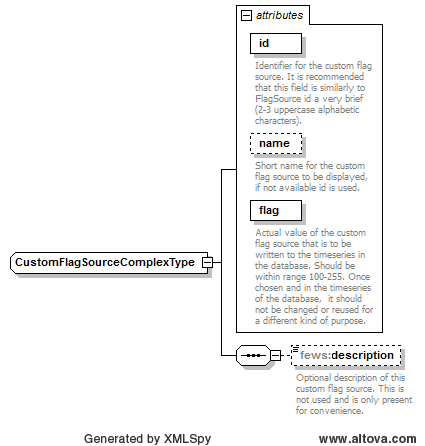...
| Excerpt | ||
|---|---|---|
| ||
Functionality to define qualifiers to time series, next to locationIds and parameterIdscustom flag sources. For example to use in conditional aggregations |
Function: | Configure predefined timesteps for a fews environmentcustom flag sources |
Where to Use? | To define verbose timesteps or to define yearly or monthly time steps custom flag sources. Currently the conditional aggregations support the use of custom defined flagsources |
Why to Use? | Yearly and monthly time steps can only be configured in the timesteps.xml. For verbose timesteps it might be |
Description: | Definition of timesteps which can be referenced from other configuration files |
If the systeem needs additional flagsources, they can be defined by using the custom flagsources. | |
Description: |
|
Available since: | 2013.01 Available since: |
Contents
| Table of Contents |
|---|
Overview
The timesteps.xml CustomFlagSources can be used to configure timesteps. This file is useful to define verbose timesteps and refer to the definition of these timesteps tofrom other configuration files.define custom flag sources. This can be usefull when the hard-coded flag sources are not sufficient.
Configuration
When available on the file system, the name of the XML file is for example:
TimeSteps 1CustomFlagSources 1.00 default.xml
TimeSteps Fixed CustomFlagSource Fixed file name for the TimeSteps configuration
...
Below the schema of the TimeStep.xml configuration files.
timeStep
Attributes;
- id: Unique Id of level threshold. This id should be used when referencing to this definition from other configuration files.
The following link describes in detail of to configure a timestep.
yearlyTimeStep
A timeStep that defines a pattern of dates in a year. This pattern will be repeated every year.
Each date in the year can have a different aggregation period (season).
The start of the aggregation period is exclusive and the end of the aggregation period is inclusive.
This yearlyTimeStep is meant for seasons, therefore limited to four dates.
If more than four dates in a year are required, then please use the monthDays option in the timeStep element instead of this yearlyTimeStep
Schema yearly time step
Below the schema of the yearly time step
Below a configuration example
...
<yearlyTimeStep id="daily">
<monthDay start="--01-01" end="--01-02" value="--01-02"/>
<monthDay start="--04-02" end="--04-03" value="--04-03"/>
<monthDay start="--07-03" end="--07-04" value="--07-04"/>
<monthDay start="--10-04" end="--10-05" value="--10-05"/>
</yearlyTimeStep>
Example
Below a configuration example
| Code Block |
|---|
<?xml version="1.0" encoding="UTF-8"?>
<customFlagSources xmlns="http://www.wldelft.nl/fews" xmlns:xsi="http://www.w3.org/2001/XMLSchema-instance" xsi:schemaLocation="http://www.wldelft.nl/fews http://fews.wldelft.nl/schemas/version1.0/customFlagSources.xsd">
<customFlagSource id="10DF" flag="100" />
<customFlagSource id="10UR" flag="101" />
<customFlagSource id="20DF" flag="102" />
<customFlagSource id="20UR" flag="103" />
<customFlagSource id="50DF" flag="104" />
<customFlagSource id="50UR" flag="105" />
<customFlagSource id="CDF" flag="106" />
<customFlagSource id="CUR" flag="107" />
</customFlagSources> |
To define a yearly time step an id should be configured. Secondly the monthDays of the time steps should be configured.
In this example the yearly time step has 4 monthDays. The start attribute defines the start of the aggregation period and the
end tag defines the end of the aggregation period. The value defines the value of the monthDay itself.
Monthly time step
A timeStep that defines a pattern of days in a month. This pattern will be repeated every month. Each day in the month can have a different aggregation period. The start of the aggregation period is exclusive and the end of the aggregation period is inclusive.
Schema monthly time step
Below the schema of the monthly time step.
Below a configuration example
| Code Block | ||
|---|---|---|
| xml | xml |
<monthlyTimeStep id="example">
<day start="01" end="02" value="02"></day>
<day start="10" end="11" value="11"></day>
</monthlyTimeStep>
|
